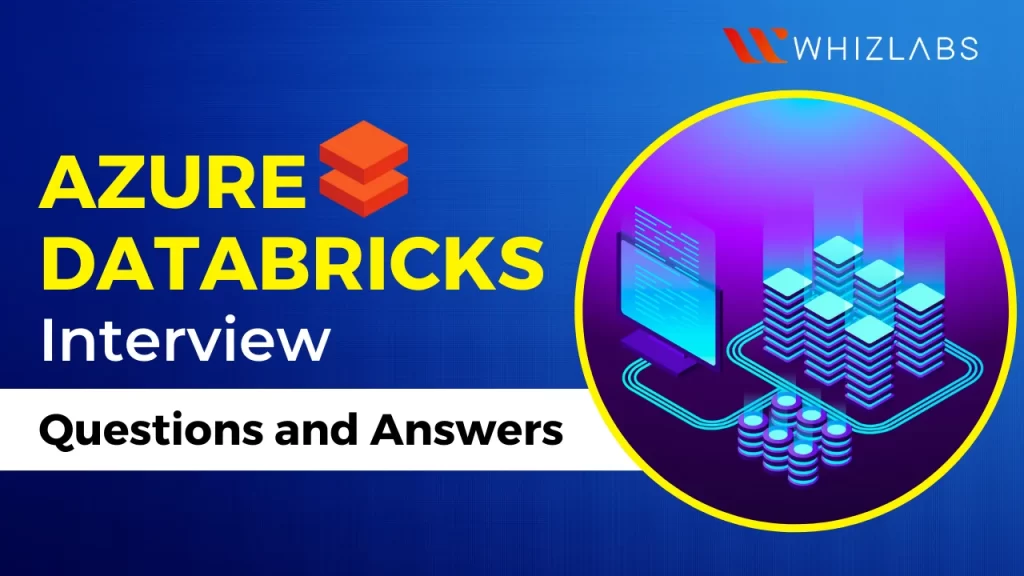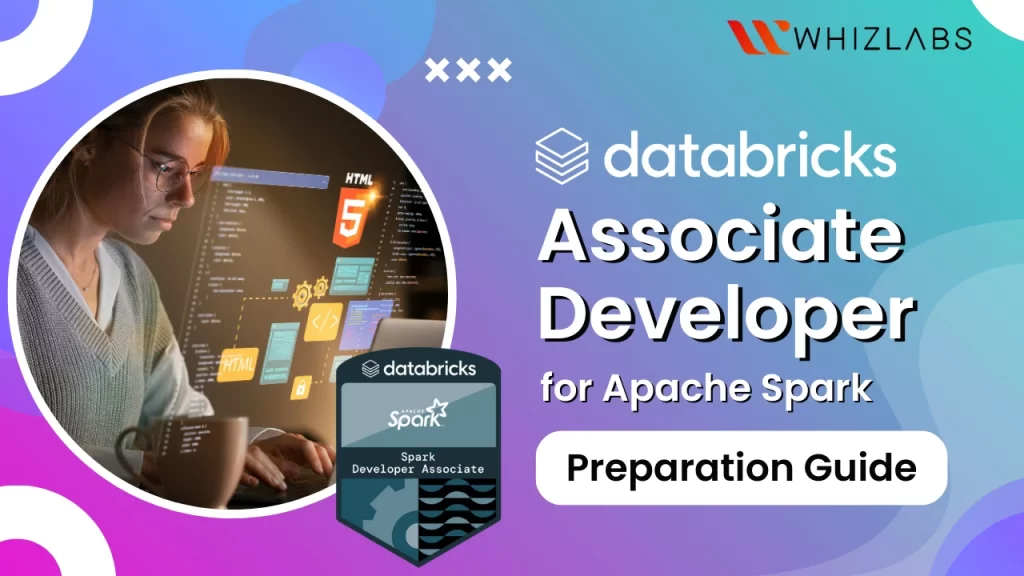Azure Databricks is a cloud-based service designed to assist in the analysis and processing of big data. In essence, Azure Databricks serves as a robust tool for extracting meaningful insights from large volumes of data, driving improvements across various aspects of your business.
In this blog, we are going to discuss the commonly asked Azure Databricks Interview Questions to prepare you for the interview process.
Let’s dig in!
Top 20+ Azure Databricks Interview Questions and Answers
Here are some frequently asked Azure Databricks Interview Questions and Answers for you:
1. Define Azure Databricks.
Azure Databricks is a cloud-based data analytics service provided by Microsoft Azure. With this, you can be able to do data analytics with massive data exist in Azure. Azure Databricks is resultant of integration between Databricks and Microsoft Azure and it is mainly introduced to support data professionals in handling massive amounts of data at a convenient pace using the cloud.
Azure Databricks is constructed on the foundation of Apache Spark, combining the adaptability of cloud computing with the robust data analytics capabilities of Apache Spark to provide top-notch AI-powered solutions. As an integral part of Azure, Azure Databricks seamlessly integrates with other Azure services, such as Azure ML. This integration is a key factor contributing to its increasing popularity.
2. What are the major features of Azure Databricks?
Here are some unique features of Azure Databricks:
- Collaborative Workspaces: Azure Databricks fosters collaboration by offering a shared environment where data engineers, data scientists, and business analysts can collaboratively contribute to the same project.
- Data Ingestion and Preparation: Azure Databricks equips users with tools to ingest and transform data from diverse sources, encompassing cloud data stores such as Azure Data Lake Storage and relational databases like Azure SQL Database.
- Machine Learning and AI: Azure Databricks serves as a comprehensive platform for constructing and deploying machine learning models, featuring seamless integrations with popular frameworks like TensorFlow and PyTorch.
- Advanced Analytics: Azure Databricks facilitates advanced analytics, covering graph processing, time-series analysis, and geospatial analysis, providing a versatile environment for in-depth exploration and interpretation of data.
3. In which cloud services does the Azure Databricks fall?
Azure Databricks comes under the PaaS cloud services. Azure Databricks offers an application development platform for running data analytics workloads. As we already know in PaaS, the customer will be solely responsible for utilizing the capabilities while the infrastructure management is taken care of by the cloud provider.
Those who work in Azure Databricks can leverage the benefits of this platform to design and develop the application rather than worrying about the underlying infrastructure. The users are involved in taking care of the data and applications they develop on the Azure platform.
4. What languages are supported in Azure Databricks?
Languages such as Python, Scala, and R can be used. With Azure Databricks, you can also use SQL. These programming languages are compatible with the Apache Spark framework. Programmers who are familiar with these languages can be able to work easily with Azure Databricks. Besides these languages, it also supports APIs such as Spark SQL, PySpark, SparkR, SparklE, Spark.api.java, and Spark.
5. What is the management plane in Azure Databricks?
The management plane helps to manage the deployment of Databricks. This means all the tools by which we can control deployments. The management plane covers the Azure portal, Azure CLI, and Databricks REST API. Data engineers cannot be able to run and manage Databricks deployments smoothly without the usage of the Management plane.
6. What are the advantages of Microsoft Azure Databricks?
Utilizing Azure Databricks comes with a variety of benefits, some of which are as follows:
- Using the managed clusters provided by Databricks can cut your costs associated with cloud computing by up to 80%.
- The straightforward user experience provided by Databricks, which simplifies the building and management of extensive data pipelines, contributes to an increase in productivity.
- Your data is protected by a multitude of security measures provided by Databricks, including role-based access control and encrypted communication, to name just two examples.
7. What are the varied pricing models supported by Azure Databricks?
Azure Databricks supports two varied pricing tiers:
- Standard Tier: This tier is used for utilizing the basic data management features.
- Premium Tier: This tier offers additional features apart from the ones achieved in the Standard Tier.
Azure Databricks offers multiple tiers, each with distinct features catering to diverse data requirements. Users can select between these tiers based on their data needs and budget considerations. Pricing varies according to the chosen region, pricing tier, and payment frequency (monthly or hourly). Azure provides the flexibility to pay in different currencies, making Azure Databricks services accessible globally.
8. What is Databricks Unit (DBU) in Azure Databricks?
In Azure Databricks, a Databricks Unit (DBU) is a computational measure that quantifies processing capability, and users are billed for each second of usage. Azure charges for virtual machines and other resources (such as blob and managed disk storage) that you provision within Azure clusters based on Databricks units (DBUs).
The DBU reflects the processing power your virtual machine utilizes per second, serving as the basis for billing in Azure Databricks. The consumption of Databricks units is directly tied to the type and size of the instance on which you run Databricks. Azure Databricks has different pricing for workloads running in the Standard and Premium tiers.
9. What is the DBU Framework in Azure Databricks?
The DBU Framework was created to simplify the development of applications on Databricks that can handle large amounts of data. The framework includes a command line interface (CLI) and two software development kits (SDKs) written in Python and Java, respectively.
10. What is a Dataframe in Azure Databricks?
Dataframe refers to a specified form of tables employed to store the data within Databricks during runtime. In this data structure, the data will be arranged into two-dimensional rows and columns to achieve better accessibility. Due to its easiness and flexibility, the data frames are highly adopted in advanced data analysis activity.
Each data frame has a blueprint( known as schema) that specifies the data name and data type of each column. The data frames look similar to the spreadsheets. The main distinction between the two is that spreadsheets can be utilized in one computer whereas a single dataframe can span various computers. That’s why datagrams help data engineers carry out data analytics on Big Data using the different computing clusters.
11. What is catching and its types?
A cache is a temporary storage that holds frequently accessed data, aiming to reduce latency and enhance speed. Caching involves the process of storing data in cache memory. When certain data is cached in the memory, subsequent access to the same data is faster due to the quick retrieval from the cache.
Cache can be classified into four types:
- Data/information caching
- Web caching
- Application caching
- Distributed caching
12. What is cluster and instances in Azure Databricks?
In Azure Databricks, a cluster refers to a group of instances that runs on the Spark applications. On the other hand, an instance refers to a virtual machine in Azure Databricks and it runs during the Databricks runtime.
A cluster comes up with combined computational resources and configurations to manage the data analytics, data engineering, and data science workloads. A cluster can be run in multiple instances.
13. What is Delta Lake Table?
In Azure Databricks, Delta lake tables are tables that store data in the delta format. Delta Lake is an extension to existing data lakes, offering customization options according to your needs.
As a fundamental element of Azure Databricks, the delta engine supports the delta lake format for data engineering, enabling the creation of modern data lakehouse/lake architectures and lambda architectures.
Data lake tables in the delta format offer several key advantages, including enhanced data
reliability, data caching, support for ACID transactions, and efficient data indexing. The delta lake format facilitates the straightforward preservation of data history, allowing the use of popular methods like creating pools of archive tables and implementing slowly changing dimensions to retain historical data.
14. What do widgets do in Azure Databricks?
Widgets play a pivotal role in the creation of notebooks and dashboards, particularly when they involve the re-execution of tasks with multiple parameters.
In the process of building notebooks and dashboards on Azure Databricks, it’s essential to thoroughly test the parameterization logic. Widgets offer a valuable tool for adding parameters to dashboards and notebooks, facilitating effective testing.
Beyond their role in building dashboards and notebooks, widgets are instrumental in exploring the results of a single query with various parameters. Leveraging the Databricks widget API, users can generate different types of input widgets, retrieve bound values, and remove input widgets. While the widget API maintains consistency across languages like Python, R, and Scala, it does exhibit slight variations when applied in SQL.
15. What are the challenges faced in the Azure Databricks?
Here are some common challenges in Azure Databricks:
- Cost Concerns: Utilizing Azure Databricks may incur significant expenses, particularly when handling large datasets that require provisioning substantial clusters for processing. Diligent resource management and strategic planning are crucial to control costs effectively.
- Complexity Challenges: Despite offering robust features, Azure Databricks can be intricate to configure and operate, especially for users unfamiliar with Apache Spark and big data processing. This complexity may pose initial barriers for some users in effectively leveraging the platform’s capabilities.
- Integration Hurdles: The integration of Azure Databricks with other tools and technologies can present difficulties, especially when dealing with platforms not inherently supported by Databricks. Custom code or third-party solutions might be necessary to establish connections between Databricks and external systems.
- Performance Considerations: Achieving optimal performance on Azure Databricks may be challenging, especially when handling extensive datasets or executing complex queries. Fine-tuning cluster configurations and crafting optimized Spark code may be essential to ensure efficient performance.
- Data Security Challenges: Managing and securing sensitive data within a big data platform like Azure Databricks can be demanding. Strategic planning and implementation of security measures, such as encryption, access controls, and data masking, are imperative to uphold the security of your data.
16. What is the control plane in Azure Databricks?
The control plane in Azure Databricks encompasses the foundational infrastructure and components responsible for overseeing and orchestrating the processing of large-scale data. This integral aspect furnishes the necessary infrastructure and components for executing big data processing, ensuring the efficient and effective analysis of substantial datasets.
The control plane plays a major role in the management and coordination of Spark applications, facilitating their execution within the Azure Databricks environment. It serves as the backbone for handling the operational aspects of data processing, contributing to the platform’s capability to process and analyze extensive volumes of data seamlessly.
17. What are Collaborative workspaces in Azure Databricks?
Collaborative workspaces in Azure Databricks create a shared environment where data engineers, data scientists, and business analysts can collaborate seamlessly on significant data projects. These workspaces facilitate the sharing of notebooks, data, and models, enabling real-time collaboration on a shared project.
The key idea behind collaborative workspaces is to provide a unified setting for professionals with diverse roles—data engineers, data scientists, and business analysts.
This environment streamlines collaboration, ensuring that everyone involved can easily access and contribute to the latest data, models, and insights within the context of a specific big data project. In essence, it enhances teamwork and knowledge sharing by fostering a collaborative and integrated workspace.
18. What is Serverless database processing in Azure Databricks?
Serverless database processing in Azure entails the capability to handle database workloads without the need for provisioning and actively managing infrastructure. This approach allows users to scale their database processing resources dynamically based on the workload’s demands, eliminating the need for meticulous capacity planning and ongoing infrastructure management.
In a serverless database processing model, users are billed based on the actual resources consumed during the processing of queries or transactions, rather than a fixed pre-allocated capacity.
This offers flexibility, cost efficiency, and the ability to adapt to varying workloads without the burden of dealing with infrastructure provisioning and maintenance tasks. Azure provides serverless database processing options for various database services, allowing users to focus more on their applications and data, rather than the underlying infrastructure.
19. What is the usage of Kafka in Azure Databricks?
Apache Kafka refers to an open-source and distributed streaming platform. It can be used in Azure Databricks for ingesting, processing, and storing massive amounts of real-time data. In Azure Databricks, you can use Kafka as a data source or data sink to construct streaming data pipelines to process the data in real-time.
20. How to process big data in Azure Databricks?
The data in the Azure Databricks can be processed in the following ways:
- Cluster Provisioning: Begin by creating a Databricks cluster, a set of virtual machines running Apache Spark. This can be done through the Azure portal or Databricks REST API.
- Data Upload: Upload your data to Databricks by storing it in Azure data stores like Blob Storage, Data Lake Storage, or Azure SQL Database. Access this data directly from your Databricks cluster.
- Data Transformation: Utilize Spark SQL, Spark Streaming, and other Spark libraries to transform your uploaded data. This may involve actions like filtering, aggregating, or pivoting to prepare it for analysis.
- Data Analysis: Leverage Databricks’ analytics tools and machine learning algorithms, such as Spark MLlib, to analyze your data. Perform tasks like training machine learning models or executing ad-hoc queries using built-in SQL analytics functions.
- Results Visualization: Use Databricks’ integrated visualization tools or export your results to external tools like Power BI for comprehensive visualization and exploration of your analytical findings.
21. How do you troubleshoot the issues in Azure Databricks?
For effective troubleshooting with Azure Databricks, the recommended starting point is the documentation. This comprehensive resource houses solutions to a diverse range of common issues. If further assistance is needed, reaching out to Databricks support is an available option.
22. How to secure sensitive data in Azure Databricks?
To secure sensitive data in Azure Databricks:
- Access Control: Manage access with Azure AD and RBAC.
- Encryption: Use Azure Key Vault for encryption at rest and SSL/TLS for data in transit.
- Data Masking: Apply techniques like anonymization and encryption for sensitive data fields.
- Network Security: Configure virtual networks and firewall rules to control access.
- Auditing and Monitoring: Utilize Azure Monitor and Log Analytics for tracking activities and identifying potential threats.
23. What is the data plane in Azure Databricks?
The data plane in Azure Databricks includes the elements that handle the storage, processing, and retrieval of data within the platform. This involves key features such as the Databricks file system (DBFS), tables, and Delta Lake for data storage, along with the Spark engine for data processing.
In essence, the data plane forms the infrastructure for data management and processing in Azure Databricks, enabling the efficient storage, processing, and analysis of substantial volumes of data.
24. What is PySpark DataFrames?
PySpark DataFrames operate as distributed collections of structured data. Essentially, a PySpark DataFrame is a distributed representation of data organized in columns, akin to relational database tables. This structured format allows for efficient optimization compared to equivalent Python or R code.
25. Define Databrick’s secret.
A Databricks secret is a secure and confidential key-value pair designed to protect sensitive information. It comprises a unique key name encapsulated within a secure environment. Each scope in Databricks allows a maximum of 1000 secrets, and there is a size limit of 128 KB for each secret. This mechanism ensures the secure storage and retrieval of confidential data within the Databricks environment.
Know More : Preparation Guide : Databricks Certified Data Engineer Professional Certification
Conclusion
Hope this article has gone through all necessary Azure Databricks interview questions addressing nearly every crucial aspect of the platform. By reviewing these questions, you can ensure that you’ve taken into account every aspect a company might be interested in.
- AWS Security Specialists: Essential in Modern Cybersecurity - August 16, 2024
- Cloud Developer Tools Showdown: AWS vs Azure vs GCP - August 14, 2024
- Master AWS Lambda and API Gateway for Application Development - August 6, 2024
- Benefits of AWS Developer Associate Certification which Can Boost Your Career - July 24, 2024
- Preparation Guide on Datadog Fundamentals Certification - July 17, 2024
- What is DLP in Power Automate? - June 5, 2024
- Top Data Engineering Certifications in 2024 - May 30, 2024
- How Difficult is Google Cloud DevOps Engineer Certification? - May 29, 2024



